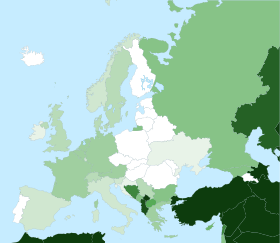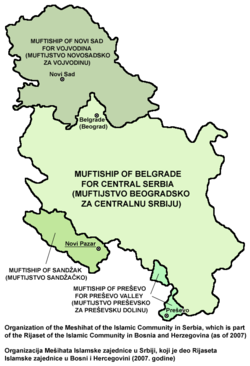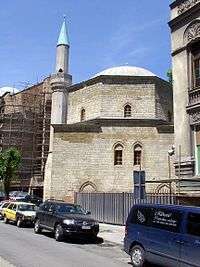Islam in Serbia
Islam spread to Serbia during the five centuries of Ottoman rule. The Muslims in Serbia are mostly ethnic Bosniaks, Albanians and minor but significant part of Roma people as well as members of the smaller ethnic groups Muslims by nationality and Gorani.

| 90–100% | |
| 70–80% | Kazakhstan |
| 50–70% | |
| 30–50% | North Macedonia |
| 10–20% | |
| 5–10% | |
| 4–5% | |
| 2–4% | |
| 1–2% | |
| < 1% |
Demographics
According to 2011 census, there were 228,658 Muslims in Serbia (3.1% of total population. The census was boycotted by some Bosniaks from the Sandžak region, since Muamer Zukorlic one of the leaders of the Party of Justice and Reconciliation, called upon his followers not to take part in the census. Moreover, the largely Albanian population of Preševo, Bujanovac and Medvedja municipalities boycotted the census, too. Thus, the actual number of Muslims in Serbia is likely to be at least about 50,000 higher. Largest concentration of Muslims in Serbia could be found in the municipalities of Novi Pazar, Tutin and Sjenica in the Sandžak region, and in the municipalities of Preševo and Bujanovac in the Preševo Valley.
| census 1921[2] | census 1991 | census 2002 | census 2011 | |||||
|---|---|---|---|---|---|---|---|---|
| Number | % | Number | % | Number | % | Number | % | |
| Muslims | 97,672 | 2.23 | 224,120 | 2.89 | 239,658 | 3.20 | 222,828 | 3.10 |
Ethnic groups
- Bosniaks and Muslims by nationality, mostly living in the Sandžak region;
- Albanians, mostly living in the Preševo Valley region;
- Romani, including Serbian-speaking groups from southern Serbia as well as Albanian-speaking groups;
- Gorani, Slavic ethnic group;
- Native Serbs, comprised only 0.04% of Serbia's total population.[3]
Geographical distribution
The municipality of Novi Pazar is home to Serbia's largest Muslim population, with 82,710 Muslims out of 100,410 inhabitants (82% of its population). The municipality of Tutin has the highest share of Muslims in Serbia, with around 94% of its population being Muslim. Sjenica Municipality has also a very large Muslim population (79%), followed by Prijepolje Municipality (45%). Most Albanians, who belong to the Islamic faith, living in Preševo, Bujanovac and Medveđa boycotted the 2011 census, but statistics from the 2002 Census shows that Muslims constitute a majority in those municipalities with 89% and 55%, respectively and in Medveđa they numbered around 29% of the population. [4]
| Municipality | Population (2011) | Number of Muslims [5] | % |
|---|---|---|---|
| Novi Pazar | 100,410 | 82,710 | 82.4% |
| City of Belgrade | 1,659,440 | 31,914 | 1.9% |
| Tutin | 31,155 | 29,220 | 93.8% |
| Sjenica | 26,392 | 20,906 | 79.2% |
| Prijepolje | 37,059 | 16,562 | 44.7% |
| Priboj | 27,133 | 5,793 | 21.4% |
| Novi Sad | 307,760 | 4,601 | 1.5% |
| Bujanovac (boycotted by Albanian minority) | 18,067 | 4,137 | 22.9% |
| Požarevac | 75,334 | 2,817 | 3.7% |
| Subotica | 141,554 | 2,756 | 1.9% |
| City of Niš | 260,237 | 2,486 | 1.0% |
| Smederevo | 108,209 | 1,670 | 1.5% |
| Zrenjanin | 123,362 | 1,391 | 1.1% |
| Nova Varoš | 16,638 | 1,384 | 8.3% |
| Beočin | 15,726 | 1,374 | 8.7% |
| Bor | 48,615 | 1,338 | 2.8% |
| Pančevo | 123,414 | 769 | 0.6% |
| Šabac | 115,884 | 760 | 0.7% |
| Loznica | 79,327 | 724 | 0.9% |
| Kragujevac | 179,417 | 665 | 0.4% |
| Preševo (boycotted by Albanian minority) | 3,080 | 593 | 19.3% |
| Medveđa (boycotted by Albanian minority) | 7,438 | 581 | 7.8% |
| Kraljevo | 125,488 | 532 | 0.4% |
| Mali Zvornik | 12,482 | 472 | 3.8% |
| Prokuplje | 44,419 | 299 | 0.7% |
| Vršac | 52,026 | 253 | 0.5% |
| Kruševac | 128,752 | 243 | 0.2% |
| Sremska Mitrovica | 79,940 | 240 | 0.3% |
| Mali Iđoš | 12,031 | 232 | 1.9% |
| Krupanj | 17,295 | 229 | 1.3% |
| Bečej | 37,351 | 206 | 0.6% |
| Bač | 14,405 | 198 | 1.4% |
| Sombor | 85,903 | 193 | 0.2% |
| Serbia (total) | 7,186,862 | 222,828 | 3.1% |
Organization
Adherents of Islam in Serbia are organized into two separate bodies: the Islamic Community in Serbia subordinate to the Islamic Community of Bosnia and Herzegovina, and the Islamic Community of Serbia founded in 2007 which traces its origins to the Principality of Serbia.[6] In 2012, the reis-ul-ulema Mustafa Cerić of Bosnia published a fatwa against Adem Zilkić, leader of the Islamic Community of Serbia, categorizing his actions as Masjid al-Dirar.[7]
The Islamic Community of Serbia (Islamska zajednica Srbije), with seat in Belgrade, is administered by reis-ul-ulema Sead Nasufović.[8] It is divided into:
- Mešihat of Serbia, with seat in Belgrade
- Mešihat of Raška, with seat in Novi Pazar
- Mešihat of Preševo, with seat in Preševo
The Islamic Community in Serbia (Islamska zajednica u Srbiji), with seat in Novi Pazar, is administered by mufti Mevlud Dudić,[9] which include:
- Islamic Community in Sandzak region or Muftiship of Sandžak, with seat in Novi Pazar, administered by mufti Mevlud Dudić.
- Islamic Community in Vojvodina or Muftiship of Novi Sad, with seat in Novi Sad, administered by mufti Fadil Murati.
- Islamic Community in Preševo Valley or Muftiship of Preševo, with seat in Preševo.
- Islamic Community in Central Serbia or Muftiship of Belgrade, with seat in Belgrade.
Gallery
 Sketches of ordinary Serbian Muslims.
Sketches of ordinary Serbian Muslims..jpg) Ottoman manuscript from Smederevo, 1526
Ottoman manuscript from Smederevo, 1526 Organization of the Rijaset of the Islamic Community of Serbia (as of 2007)
Organization of the Rijaset of the Islamic Community of Serbia (as of 2007) Organization of the Mešihat of the Islamic Community in Serbia, which is part of the Rijaset of the Islamic Community in Bosnia and Herzegovina (as of 2007)
Organization of the Mešihat of the Islamic Community in Serbia, which is part of the Rijaset of the Islamic Community in Bosnia and Herzegovina (as of 2007)- Mosque in Sjenica
 Mosque in Preševo
Mosque in Preševo
See also
References
- "Religious Composition by Country, 2010-2050". Pew Research Center. 12 April 2015. Retrieved 22 October 2017.
- "[Projekat Rastko] Svetlana Radovanovic - Demographic Growth and Ethnodemographic Changes in the Republic of Serbia". www.rastko.rs.
- Government of Serbia 2014, p. 194.
- "Zilkić ponovo izabran" (in Serbian). Radio Television of Serbia. 13 February 2010. Retrieved 16 February 2014.
- "Reakcije na fetvu protiv reisa IZ Srbije" (in Bosnian). Al Jazeera Balkans. 14 November 2012. Retrieved 16 February 2014.
- "Islamska zajednica Srbije: Sead Nasufović novi reis-l-ulema". www.novosti.rs (in Serbian). Retrieved 2020-05-19.
- "POSLE OSAM GODINA SUKOBA Zilkić pozvao Dudića da se ujedine u jednu Islamsku zajednicu" (in Serbian). Blic. 22 March 2016. Retrieved 5 January 2017.
External links
- Islamic community of Serbia (IZS)
- Islamic community in Serbia (IZuS)
- Publishing house of ICinS
- Faculty of Islamic studies in Novi Pazar
| Wikimedia Commons has media related to Islam in Serbia. |
| Wikiquote has quotations related to: Islam in Serbia |

